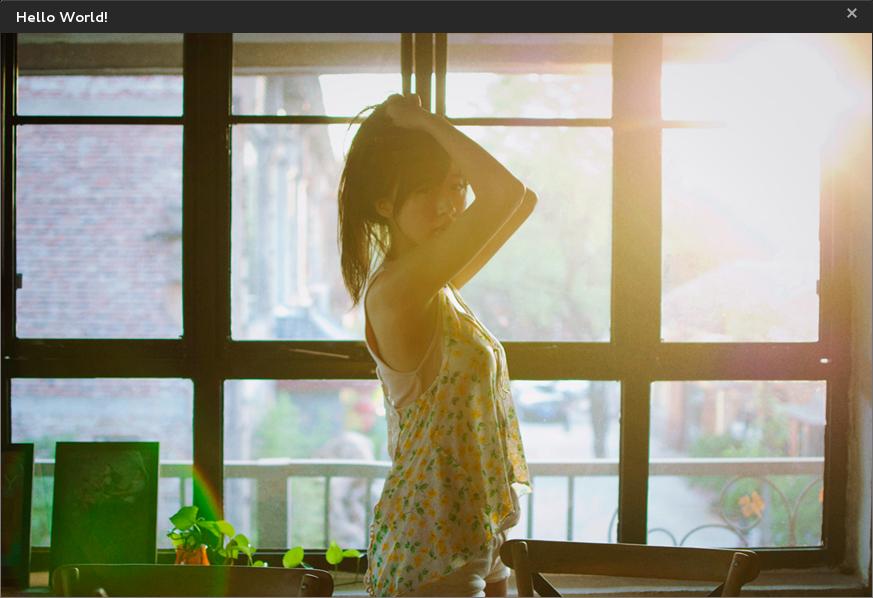前言
个人喜好原因,写OpenGL的程序都喜欢用SDL做框架,没有Qt那么臃肿,也没有glut那么坑跌,在不失灵活性的情况下保持了自己的轻量。SDL2.0在今年很早的时候时候就发布了,几天就来好好试用一下。
下面是SDL2主要的几点新特性:
全硬件加速
支持OpenGL3.0+
支持OpenGL ES
支持Android和iOS
跨平台支持Windows,MacOSX和LInux
修改了很多bug
...
编译安装
从官网下载最新版2.0.1的源码,解压后cd进目录,依次执行:
./autogen
./configura
make
sudu make install
一切顺利的话SDL2.0就安装编译好了。
库文件在 /usr/local/lib中
头文件在 /usr/local/include/SDL2 中。
加载显示一张图片
感觉SDL的1.2和2.0差别还是挺大的。看代码:
#include <iostream>
#include <SDL2/SDL.h>
#include <GL/gl.h>
#include <GL/glu.h>
using namespace std;
int main()
{
//Start SDL
if (SDL_Init(SDL_INIT_VIDEO) != 0)
{
cout << "SDL_Init Error: " << SDL_GetError() << endl;
return 1;
}
SDL_Window *win = SDL_CreateWindow("Hello World!", 100, 100, 871, 564, SDL_WINDOW_SHOWN);
if (win == nullptr)
{
cout << "SDL_CreateWindow Error: " << SDL_GetError() << endl;
return 1;
}
SDL_Renderer *ren = SDL_CreateRenderer(win, -1, SDL_RENDERER_ACCELERATED|SDL_RENDERER_PRESENTVSYNC);
if (ren == nullptr)
{
cout << "SDL_CreateRenderer Error: " << SDL_GetError() << endl;
return 1;
}
SDL_Surface *bmp = SDL_LoadBMP("girl.bmp");
if (bmp == nullptr)
{
cout << "SDL_LoadBMP Error: " << SDL_GetError() << endl;
return 1;
}
SDL_Texture *tex = SDL_CreateTextureFromSurface(ren, bmp);
SDL_FreeSurface(bmp);
if (tex == nullptr)
{
cout << "SDL_CreateTextureFromSurface Error: " << SDL_GetError() << endl;
return 1;
}
SDL_RenderClear(ren);
SDL_RenderCopy(ren, tex, NULL, NULL);
SDL_RenderPresent(ren);
SDL_Delay(2000);
SDL_DestroyTexture(tex);
SDL_DestroyRenderer(ren);
SDL_DestroyWindow(win);
//Quit SDL
SDL_Quit();
cout<<"Hello"<<endl;
return 1;
}代码还是蛮简单的,先是初始化SDL,再依次 初始化Window ->初始化Render ->加载图片 -> 生成纹理 ->渲染纹理 ->释放内存,记得在当前目录放一张 girl.bmp.运行结果:
基于SDL2的OpenGL编程
相对于SDL1.2中的函数接口,SDL2改变得还是比较大的,其中的设计得会更加“现代化”一些,用起来会更加方便,以前用过SDL1.2的需要重新熟悉一下。
#include <iostream>
#include <SDL2/SDL.h>
#include <GL/gl.h>
#include <GL/glu.h>
using namespace std;
const int SCREEN_WIDTH = 800;
const int SCREEN_HEIGHT =600;
SDL_Window *mainwindow; /* Our window handle */
SDL_GLContext maincontext; /* Our opengl context handle */
/* A simple function that prints a message, the error code returned by SDL,
* and quits the application */
void sdldie(const char *msg)
{
printf("%s: %s\n", msg, SDL_GetError());
SDL_Quit();
exit(1);
}
void quit( int code )
{
SDL_Quit( );
/* Exit program. */
exit( code );
}
void checkSDLError(int line = -1)
{
#ifndef NDEBUG
const char *error = SDL_GetError();
if (*error != '\0')
{
printf("SDL Error: %s\n", error);
if (line != -1)
printf(" + line: %i\n", line);
SDL_ClearError();
}
#endif
}
void initGL( int width, int height )
{
float ratio = (float) width / (float) height;
// Our shading model--Gouraud (smooth).
glShadeModel( GL_SMOOTH );
// Set the clear color.
glClearColor( 0, 0, 0, 0 );
// Setup our viewport.
glViewport( 0, 0, width, height );
//Change to the projection matrix and set our viewing volume.
glMatrixMode( GL_PROJECTION );
glLoadIdentity();
gluPerspective( 60.0, ratio, 1.0, 100.0 );
}
void initSDL()
{
if (SDL_Init(SDL_INIT_VIDEO) < 0) /* Initialize SDL's Video subsystem */
sdldie("Unable to initialize SDL"); /* Or die on error */
/* Request opengl 3.2 context.
* SDL doesn't have the ability to choose which profile at this time of writing,
* but it should default to the core profile */
SDL_GL_SetAttribute(SDL_GL_CONTEXT_MAJOR_VERSION, 2);
SDL_GL_SetAttribute(SDL_GL_CONTEXT_MINOR_VERSION, 1);
/* Turn on double buffering with a 24bit Z buffer.
* You may need to change this to 16 or 32 for your system */
SDL_GL_SetAttribute(SDL_GL_DOUBLEBUFFER, 1);
SDL_GL_SetAttribute(SDL_GL_DEPTH_SIZE, 24);
/* Create our window centered at 512x512 resolution */
mainwindow = SDL_CreateWindow("OpenGL in SDL2", SDL_WINDOWPOS_CENTERED, SDL_WINDOWPOS_CENTERED,
SCREEN_WIDTH, SCREEN_HEIGHT, SDL_WINDOW_OPENGL | SDL_WINDOW_SHOWN|SDL_WINDOW_RESIZABLE);
if (!mainwindow) /* Die if creation failed */
sdldie("Unable to create window");
checkSDLError(__LINE__);
/* Create our opengl context and attach it to our window */
maincontext = SDL_GL_CreateContext(mainwindow);
checkSDLError(__LINE__);
/* This makes our buffer swap syncronized with the monitor's vertical refresh */
SDL_GL_SetSwapInterval(1);
}
void renderGL()
{
// Clear the color and depth buffers.
glClear( GL_COLOR_BUFFER_BIT | GL_DEPTH_BUFFER_BIT );
// We don't want to modify the projection matrix. */
glMatrixMode( GL_MODELVIEW );
glLoadIdentity( );
// Move down the z-axis.
glTranslatef( 0.0, 0.0, -5.0 );
//Draw a square
glBegin(GL_QUADS);
glColor3f(1.0f,0.0f,0.0f);
glVertex3f(-1.0f , -1.0f , 1.0f );
glColor3f(0.0f,1.0f,0.0f);
glVertex3f( 1.0f , -1.0f , 1.0f );
glColor3f(0.0f,0.0f,1.0f);
glVertex3f( 1.0f , 1.0f , 1.0f );
glColor3f(1.0f,1.0f,0.0f);
glVertex3f(-1.0f , 1.0f , 1.0f );
glEnd();
SDL_GL_SwapWindow(mainwindow);
}
void resizeGL(int width,int height)
{
if ( height == 0 )
{
height = 1;
}
//Reset View
glViewport( 0, 0, (GLint)width, (GLint)height );
//Choose the Matrix mode
glMatrixMode( GL_PROJECTION );
//reset projection
glLoadIdentity();
//set perspection
gluPerspective( 45.0, (GLfloat)width/(GLfloat)height, 0.1, 100.0 );
//choose Matrix mode
glMatrixMode( GL_MODELVIEW );
glLoadIdentity();
}
void handleKeyEvent( SDL_Keysym* keysym )
{
switch( keysym->sym )
{
case SDLK_ESCAPE:
quit( 0 );
break;
case SDLK_SPACE:
cout<<"Space"<<endl;
break;
default:
break;
}
}
void handleEvents()
{
// Our SDL event placeholder.
SDL_Event event;
//Grab all the events off the queue.
while( SDL_PollEvent( &event ) ) {
switch( event.type ) {
case SDL_KEYDOWN:
// Handle key Event
handleKeyEvent( &event.key.keysym );
break;
case SDL_QUIT:
// Handle quit requests (like Ctrl-c).
quit( 0 );
break;
case SDL_WINDOWEVENT:
if(event.window.event == SDL_WINDOWEVENT_RESIZED)
{
if ( mainwindow )
{
int tmpX,tmpY;
SDL_GetWindowSize(mainwindow,&tmpX,&tmpY);
resizeGL(tmpX, tmpY);
}
}
SDL_GL_SwapWindow(mainwindow);
break;
}
}
}
/* Our program's entry point */
int main(int argc, char *argv[])
{
initSDL();
initGL(SCREEN_WIDTH, SCREEN_HEIGHT);
renderGL( );
while(true)
{
/* Process incoming events. */
handleEvents( );
/*Render scene*/
renderGL();
}
return 0;
}需要说明的时候__LINE__这个宏,它主要是用来调试的,表示当前的代码行数,
用下面的命令来编译:
g++ test.cpp -o test -lSDL2 -lGL -lGLU -std=c++11
运行结果:
编译运行Android中的SDL2
注:最好在Ubuntu 下来进行交叉编译,测试过Opensuse,未果。
在SDL的源码文件夹中有相应的android工程模板 android-project.
首先是交叉编译。
1.创建android-project/jni/SDL文件夹
2.将SDL源码目录下的src 和include文件夹还有Android.mk拷贝到刚才创建的目录
3.在 android-project/jni/src 中创建main.c
这里从手机里面加载一张图片来显示。
#include "SDL.h"
int main(int argc, char* argv[])
{
//Start SDL
if (SDL_Init(SDL_INIT_VIDEO) != 0)
{
return 1;
}
SDL_Window *win = SDL_CreateWindow("Hello World!", SDL_WINDOWPOS_CENTERED, SDL_WINDOWPOS_CENTERED, 512, 512, SDL_WINDOW_SHOWN);
SDL_Renderer *ren = SDL_CreateRenderer(win, -1, SDL_RENDERER_ACCELERATED|SDL_RENDERER_PRESENTVSYNC);
SDL_Surface *bmp = SDL_LoadBMP("/sdcard/boss.bmp");
SDL_Texture *tex = SDL_CreateTextureFromSurface(ren, bmp);
SDL_FreeSurface(bmp);
SDL_RenderClear(ren);
SDL_RenderCopy(ren, tex, NULL, NULL);
SDL_RenderPresent(ren);
SDL_Delay(2000);
SDL_DestroyTexture(tex);
SDL_DestroyRenderer(ren);
SDL_DestroyWindow(win);
//Quit SDL
SDL_Quit();
return 1;
}修改src/Android.mk文件,将YourSourceHere.c改为main.c.
4.在手机的sdcard根目录下面放一个boss.bmp,待会加载。
5.终端cd进android-project,执行
$NDK_ROOT/ndk-build
编译正常的话可以得到下面的结果:
6.用eclipse将项目导入,运行,得到结果:
参考
在Eclipse中配置SDL2.0 for Android - http://adolfans.github.io/sdltutorialcn/blog/2013/04/23/set-up-sdl2-for-android-in-eclipse/

























 907
907

 被折叠的 条评论
为什么被折叠?
被折叠的 条评论
为什么被折叠?








